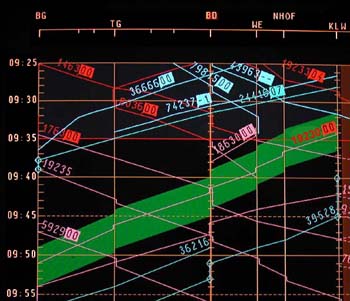
The dispatcher's green band
In order for the dispatcher to see more clearly the tolerance within which trains will not conflict with one another and connections will wait, the time-distance diagram can display a green band (Grünband) for each train.
This extends both above and below the line representing the scheduled movement of the train:
(Click on image for a larger
version and more details)
The part above the scheduled path shows how much ahead of schedule the train could operate. This is relevant for freight trains. It tells the dispatcher how much ahead of schedule he can allow a freight train to run without getting in the way of other trains.
The part of the green band below the scheduled path shows how late the train - either freight or passenger - can become without either getting in the way of other trains or exceeding the tolerance beyond which connecting trains (and buses) depart without waiting.
For example, in Baden (BD in the display above), the green band reflects the scheduled departure of connecting buses. After Baden, the green band extends further below the schedule line because the train's next connections are much further along the line.
For each of the 10,000 trains in the Zurich dispatcher's territory in the national schedule, personnel at the center must enter the data for the display of the train's green band, which means two months of work for two people at the Zurich dispatching center every spring, before the new national schedule goes into effect.
The green band appears on the screen only when the dispatcher requests it. If the train's path is outside its green zone, and the green zone is currently not displayed, the train's path is white on the display.
At each workplace in the dispatching center, a dispatcher can call up a list of all trains whose current position or forecasted paths are outside of their green bands. This list is especially useful at low-traffic times of the day, when only one or two dispatchers are on duty, as it provides an overview of the network and possible emerging problems.
This site was originally assembled in March 2001. Comments are welcome.
Copyright © 2001-2005 George B. Raymond, Jr. Disclaimer


